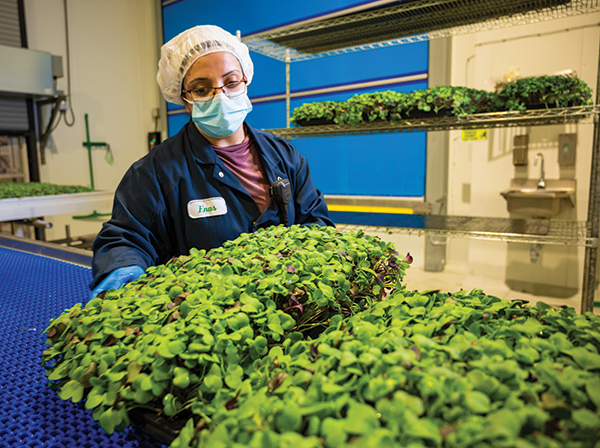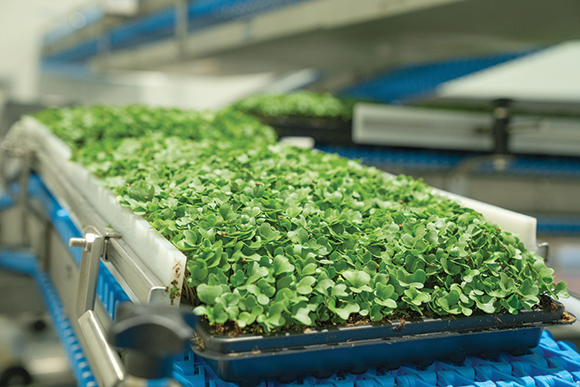With cold temperatures cocooning Québec for more than half the year, the province’s growing season is quite limited. Canada’s leading vertical farming company, GoodLeaf Farms, has developed an answer to this environmental and economic problem.
"Canada imports somewhere between 80-90% of their leafy greens, and there hasn’t been a domestic alternative, so one of the driving forces has been creating that domestic alternative for Canada," says Barry Murchie, GoodLeaf’s CEO.
While most open-field farms harvest only one crop a year, GoodLeaf’s climate-controlled indoor farms produce 40 crops of microgreens and 20 crops of baby greens annually. This dramatic increase in productivity is tapping into the needs of a market that is spreading rapidly across Canada.
Currently, the company’s large-scale, fully commercialized farms in Guelph, Ontario, and Calgary, Alberta, supply microgreens and baby greens, including pea shoots, micro radish, kale, spinach, arugula and spring mix to retail locations and restaurants throughout Ontario and Alberta.
In November, the company announced it was expanding into Québec with a new 100,000-sq.-ft. farm in Longueuil. Backed by the support of a $7 million loan from the Government of Québec and several smaller grants from multiple economic development agencies, the new farm is on track to open in the middle of 2023. This facility will provide approximately 2 million pounds of produce annually to Québec and Atlantic Canada’s retailers and hospitality sector.
Murchie attributes GoodLeaf’s decision to expand in Québec to six key site selection factors.
"Canada imports somewhere between 80-90% of their leafy greens, and there hasn’t been a domestic alternative, so one of the driving forces has been creating that domestic alternative for Canada,"
– Barry Murchie, CEO, GoodLeaf Farms
"One is a supportive environment relative to the government and the regulation,” he explains. “Another is power availability and water availability and the predictability and confidence in both of those. And then proximity to our customers as well as from a freight and a supply chain and logistics perspective.
"Also, proximity to a workforce,” Murchie continues. “We have many technology jobs from the horticulture side to automation to the maintenance of the farm as well as many hourly positions as well as quality assurance roles and horticulture roles, so it can bring a lot of employment. We want to make sure we are putting ourselves in a place where the talent pool is going to be aligned with our needs."
"We fortunately have great cooperation and interest from various stakeholders across Canada, both provincially and at the municipal level, about attracting a company like ours. You know, we are fundamentally creating an opportunity for import substitution where the vast majority of our product right now is coming from California and Arizona, and Canadians as consumers and as government partners would like to see alternatives within Canada, a domestic supply."
The Tech Behind the Taste
With vertical farming, plants no longer need sun and soil to thrive. Instead, GoodLeaf grows its produce on multiple levels of hydroponic trays, fixed with LED lights engineered to mimic the spring sun. This method not only maximizes photosynthesis but excludes pesticides, herbicides and fungicides.
"We are growing our product without the aid of any natural light. It fits into the category of controlled environment agriculture. You control everything from your seed density, seed distribution and germination," says Murchie, "Then, within the grow room, you’re controlling the temperature, the humidity, the CO2 levels, the irrigation cycle, the nutrient load, the lighting and the lighting intensity. So, you’re really able to create an environment that is absolutely perfect for plants throughout the whole growth cycle."
Alongside the environment, GoodLeaf can control the morphology of the plants, including the leaf-to-stem ratio, the colors and the nutrient density. "It becomes just another level up in controlled agriculture where you can do it faster and more predictably."
In traditional farming methods such as open-field farming, farmers are exposed to the unpredictability of mother nature. Due to interference from insects, animals, weather and other outside factors, it typically takes 40-60 days to grow arugula, spring mix, kale and spinach.
By eliminating these disturbances and introducing technology, GoodLeaf can grow these plants in 18 days. Not only does this innovation speed up the growing process, but it also allows plants that struggle to thrive outside, such as microgreens, to flourish.

Canada imports 80-90% of its leafy greens.
"Because they are immature plants, and they don’t grow high enough off the ground. They’re just not sturdy enough to grow in an open-field format. Vertical farming has created an environment where we can control all of that. We grow our microgreen from seed to packet in eight days."
By efficiently producing microgreens, GoodLeaf entered an untapped market.
Microgreens can hold up to 40 times the nutrient density of more mature plants. According to Murchie, "Some micro greens — for example, micro broccoli — have been confirmed to be a medicinal product as well. It’s an anti-toxin, it’s an antioxidant, and in some instances, it’s been shown to have significant health benefits in a number of ways. This allows us to bring a new category into produce by leveraging this technology.
"If you get the plant at a young age, you are capturing all of these nutrients, which comes across as flavor, that are bioavailable to humans. As a result, it can really make a difference in people’s diets."
An Eco-friendly Alternative
From farm to table, GoodLeaf seeks to improve the health of its consumers. The technology vertical farming offers allows the company to create a carbon footprint that is significantly lower than open-field farming.
Unlike GoodLeaf, open-field farmers must combat pests and other environmental obstacles. Therefore, they coat their plants in chemicals that are later washed off three times in a chlorine bath, wasting large quantities of water. Open-field farming also relies on large machinery to prepare the land. According to Janzen Schroeder Ag Law, a modern 300-horsepower Tier 4 tractor generates 51,950 pounds of CO2 per year.
"All of that combined creates a carbon footprint for open field farming that’s significantly above where we are because we are local, because we don’t use those chemicals, we don’t use pesticides, we use very little water — approximately 5% of the water of open-field farming — we don’t need to triple wash our product in a chlorine bath to get rid of the pesticides. All of those things bring us to a significantly reduced carbon footprint," says Murchie.
Previously, most of Canada’s leafy greens were imported from the United States. By creating a domestic alternative, GoodLeaf is eliminating the excess emissions produced by trucks traveling thousands of miles for delivery.
These sustainable strides coincide with many of the import, fuel-efficient moves Québec has been making. The Canadian province is currently known as the jurisdiction with the highest number of EV charging station locations per capita in North America.
This spring, Montreal is set to launch its Réseau Express Métropolitain, an automated electric train powered 100% by locally manufactured renewable energy. There are more than 25 stations expected to be constructed throughout Greater Montreal, including a line to Montréal-Trudeau International Airport.
Hungry for More
"It’s the cleanest product that’s available on the market," explains Murchie.
"We put ourselves in Québec because it’s a very supportive ecosystem and because the consumers in Québec are very sophisticated in their taste. This technology provides the highest quality, the highest nutrient density and the longest shelf life. We think that all of these attributes, as well as doing that in a sustainable way with a carbon footprint that’s around half of that of open-field farming, are something all of the consumers in Québec will greatly appreciate, so we selected it as a key area for our next round.
As for the future of GoodLeaf, the company has the potential to go global, Murchie says, given the number of inquiries coming in from various parts of the world “about us considering building farms in areas where, from an environmental perspective, they are challenged, whether they’re too cold, too hot or they don’t have the water resources or the arable land and they’re long distances as far as importing product. We get a lot of those inquiries and at some point, we will look at activating those."
